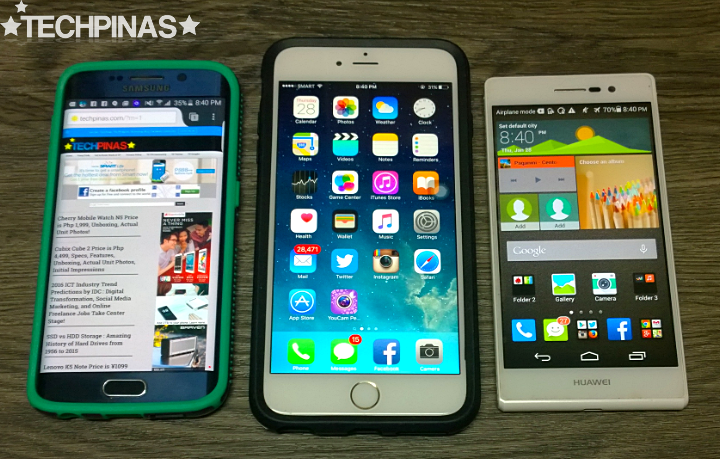2015 Top Smartphone Seller Worldwide is Samsung, According to IDC : Huawei and Lenovo Saw Tremendous Sales Growth Last Year!
Despite the year-on-year slide in its sales growth, Korean electronics giant Samsung managed to still be world's number one smartphone vendor last year based on raw figures gathered by the International Data Corporation (IDC) Worldwide Quarterly Mobile Phone Tracker.
The premier global provider of market intelligence - IDC - shared that the worldwide smartphone market saw a total of 1,432.9 million units shipped in 2015 marking the highest year of shipments on record, up 10.1% from the 1,301.7 million units shipped in 2014!

Samsung finished the year with 324.8 million units shipped, which is up only 2.1% from its 318.2 million shipments in 2014. With stradily increasing pressure in the high-end bracket from Apple, and at the low end to midrange echelon from Chinese manufacturers Xiaomi, Huawei, Oppo, ZTE, and others, Samsung definitely faces a multi-front battle.
Demand for Apple iPhone 6S and 6S Plus in China and the US elevated Apple in 2015 to 231.5 million units shipped in the year. This represents 20.2% growth from the 192.7 million units shipped in 2014 -- despite criticism that the new models look identical to their predecessors and the fact that the average selling price of the iPhone climbed to $691, up from $687 one year ago. With such high ASP for its best-selling handsets, Apple still has more than 90% of the industry profits from shipping smartphones.

But perhaps the biggest success story in the mobile industry last year belongs to Chinese electronics company Huawei. According to IDC, Huawei got the strongest year-over-year growth among the top five vendors at 37%. They added, "Huawei also became the fourth mobile phone vendor in history to ship over 100 million smartphones in a year (preceded only by Nokia, Samsung and Apple). Of the key brands originating from China, Huawei has consistently expanded its presence and share on the back of affordable handsets in emerging markets, combined with increasingly competitive flagship models."

Huawei's success is also mirrored by one of its main competitors in China, Lenovo, which saw a 24.5% increase in its shipments from 2014 to 2015 and a whopping 43.6% growth in its Q4 2015 shipment volume versus the same quarter in 2014!
"After its acquisition of Motorola, [4th largest smartphone vendor of 2015] Lenovo was still trying to find its feet amidst organizational changes while facing greater competition in its domestic market from smaller, local competitors at the low end. The Motorola brand, strong in 2014 in the Americas with the Moto G and Moto X, saw fewer groundbreaking new models in 2015. The Motorola name will be shortened to just 'Moto' and be used for high-end devices while the "Vibe" brand from Lenovo will represent the low-end. Lenovo will also put its faith entirely in Motorola as they have elected Moto to design, develop, and manufacture smartphone products going forward," shares IDG.
Meanwhile, despite ramping up in India and launching in Brazil, Xiaomi spent 2015 trying to encourage consumers - especially in China where it gets 90% of its sales - to transition away from the low-end range of models into more midrange releases. Although its sales performance last year wasn't as impressive as in previous years, on the basis of this growth, Xiaomi was still able to widen the gap from number six, LG.

"With heavy saturation in many mature smartphone markets such as the U.S., Europe, and China, many vendors have placed a renewed focus on pushing premium-looking mid-tier devices as a new value proposition to consumers in both developed and emerging markets. Samsung has found success in this segment with its A-Series, and Huawei with its Honor brand. We expect similar devices to appear in 2016 from a variety of vendors that will focus on affordable value without neglecting performance and aesthetics," explains Mr. Anthony Scarsella, Research Manager at IDC's Worldwide Quarterly Mobile Phone Tracker.
Based on TechPinas Traffic Data from 2015, some of the top smartphones in the Philippines by interest are Samsung Galaxy J1, Lenovo A7000, Samsung Galaxy J5, Lenovo A7000 Plus, Apple iPhone 6S Plus, and Samsung Galaxy J7 -- reflecting data on a global scale. Interestingly, however, Pinoy handset releases from Cherry Mobile, Starmobile, and MyPhone as well as those by Taiwanese company Asus and other players like Oppo and O+ USA also led other models by interest within the same period in our local market.
The premier global provider of market intelligence - IDC - shared that the worldwide smartphone market saw a total of 1,432.9 million units shipped in 2015 marking the highest year of shipments on record, up 10.1% from the 1,301.7 million units shipped in 2014!

Samsung finished the year with 324.8 million units shipped, which is up only 2.1% from its 318.2 million shipments in 2014. With stradily increasing pressure in the high-end bracket from Apple, and at the low end to midrange echelon from Chinese manufacturers Xiaomi, Huawei, Oppo, ZTE, and others, Samsung definitely faces a multi-front battle.
| Vendor | 2015 Shipment Volumes (in Millions) | 2015 Market Share | 2014 Shipment Volumes | 2014 Market Share | Year-Over-Year Growth |
| 1. Samsung | 324.8 | 22.7% | 318.2 | 24.4% | 2.1% |
| 2. Apple | 231.5 | 16.2% | 192.7 | 14.8% | 20.2% |
| 3. Huawei | 106.6 | 7.4% | 73.8 | 5.7% | 44.3% |
| 4. Lenovo | 74.0 | 5.2% | 59.4 | 4.6% | 24.5% |
| 5. Xiaomi | 70.8 | 4.9% | 57.7 | 4.4% | 22.8% |
| Others | 625.2 | 43.6% | 599.9 | 46.1% | 4.2% |
| Total | 1,432.9 | 100.0% | 1,301.7 | 100.0% | 10.1% |
| Lenovo + Motorola | 73.9 | 5.16% | 93.7 | 7.20% | -21.1% |
Demand for Apple iPhone 6S and 6S Plus in China and the US elevated Apple in 2015 to 231.5 million units shipped in the year. This represents 20.2% growth from the 192.7 million units shipped in 2014 -- despite criticism that the new models look identical to their predecessors and the fact that the average selling price of the iPhone climbed to $691, up from $687 one year ago. With such high ASP for its best-selling handsets, Apple still has more than 90% of the industry profits from shipping smartphones.

But perhaps the biggest success story in the mobile industry last year belongs to Chinese electronics company Huawei. According to IDC, Huawei got the strongest year-over-year growth among the top five vendors at 37%. They added, "Huawei also became the fourth mobile phone vendor in history to ship over 100 million smartphones in a year (preceded only by Nokia, Samsung and Apple). Of the key brands originating from China, Huawei has consistently expanded its presence and share on the back of affordable handsets in emerging markets, combined with increasingly competitive flagship models."

Huawei's success is also mirrored by one of its main competitors in China, Lenovo, which saw a 24.5% increase in its shipments from 2014 to 2015 and a whopping 43.6% growth in its Q4 2015 shipment volume versus the same quarter in 2014!
| Vendor | 4Q15 Shipment Volumes (in Millions) | 4Q15 Market Share | 4Q14 Shipment Volumes | 4Q14 Market Share | Year-Over-Year Growth |
| 1. Samsung | 85.6 | 21.4% | 75.1 | 19.9% | 14.0% |
| 2. Apple | 74.8 | 18.7% | 74.5 | 19.7% | 0.4% |
| 3. Huawei | 32.4 | 8.1% | 23.6 | 6.3% | 37.0% |
| 4. Lenovo | 20.2 | 5.1% | 14.1 | 3.7% | 43.6% |
| 5. Xiaomi | 18.2 | 4.6% | 16.5 | 4.4% | 10.0% |
| Others | 168.3 | 42.1% | 174.0 | 46.1% | -3.3% |
| Total | 399.5 | 100.0% | 377.8 | 100.0% | 5..7% |
| Lenovo + Motorola | 20.2 | 8.1% | 24.7 | 6.5% | -18.1% |
"After its acquisition of Motorola, [4th largest smartphone vendor of 2015] Lenovo was still trying to find its feet amidst organizational changes while facing greater competition in its domestic market from smaller, local competitors at the low end. The Motorola brand, strong in 2014 in the Americas with the Moto G and Moto X, saw fewer groundbreaking new models in 2015. The Motorola name will be shortened to just 'Moto' and be used for high-end devices while the "Vibe" brand from Lenovo will represent the low-end. Lenovo will also put its faith entirely in Motorola as they have elected Moto to design, develop, and manufacture smartphone products going forward," shares IDG.
Meanwhile, despite ramping up in India and launching in Brazil, Xiaomi spent 2015 trying to encourage consumers - especially in China where it gets 90% of its sales - to transition away from the low-end range of models into more midrange releases. Although its sales performance last year wasn't as impressive as in previous years, on the basis of this growth, Xiaomi was still able to widen the gap from number six, LG.

The Big Three of 2015 : Samsung, Apple, Huawei
"With heavy saturation in many mature smartphone markets such as the U.S., Europe, and China, many vendors have placed a renewed focus on pushing premium-looking mid-tier devices as a new value proposition to consumers in both developed and emerging markets. Samsung has found success in this segment with its A-Series, and Huawei with its Honor brand. We expect similar devices to appear in 2016 from a variety of vendors that will focus on affordable value without neglecting performance and aesthetics," explains Mr. Anthony Scarsella, Research Manager at IDC's Worldwide Quarterly Mobile Phone Tracker.
Based on TechPinas Traffic Data from 2015, some of the top smartphones in the Philippines by interest are Samsung Galaxy J1, Lenovo A7000, Samsung Galaxy J5, Lenovo A7000 Plus, Apple iPhone 6S Plus, and Samsung Galaxy J7 -- reflecting data on a global scale. Interestingly, however, Pinoy handset releases from Cherry Mobile, Starmobile, and MyPhone as well as those by Taiwanese company Asus and other players like Oppo and O+ USA also led other models by interest within the same period in our local market.




.jpg)